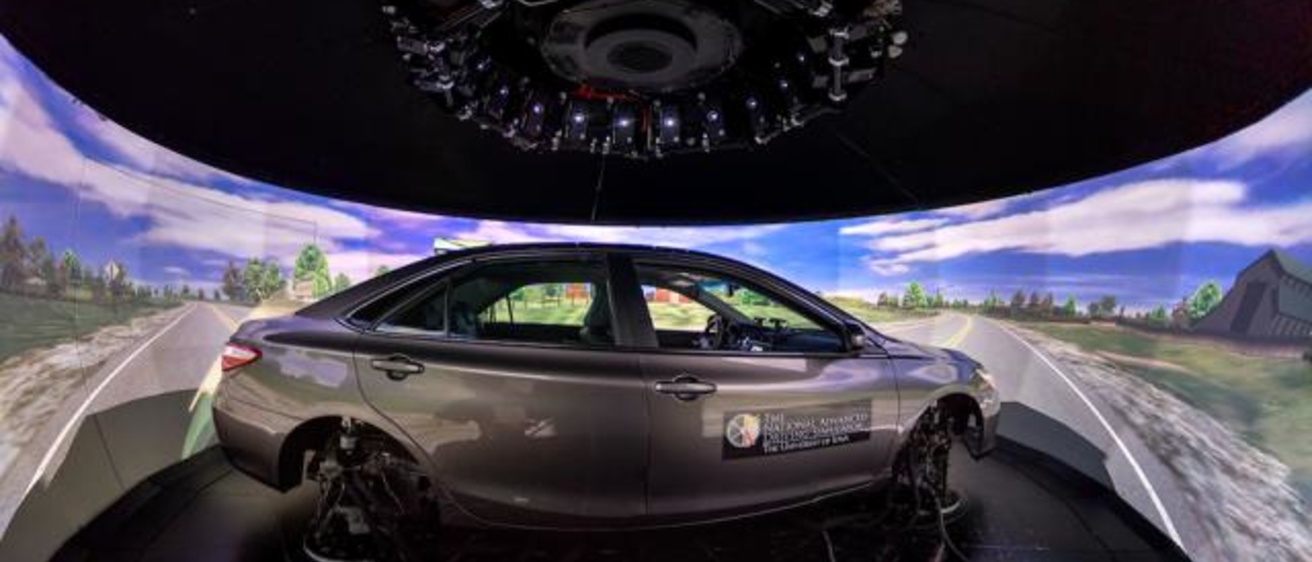By Hayley Bruce
UI Strategic Communication
The University of Iowa’s National Advanced Driving Simulator has been awarded a $1.4 million University Transportation Center grant from the U.S. Department of Transportation (DOT) Research and Innovation Technology Administration.
The UI, which is the lead institution, will share the grant with four other consortium institutions: the University of Central Florida, University of Wisconsin–Madison, University of Massachusetts–Amherst, and the University of Puerto Rico–Mayaguez. Each consortium member is home to one or more interactive driving simulators used by faculty, staff, and students from human factors, engineering, computer science, and psychology.
The interdisciplinary center, named Safety Research Using Simulation (SAFER-SIM), will address the U.S. DOT’s research priority of promoting safety. SAFER-SIM researchers from five institutions will collaborate to conduct research using innovative simulation techniques, sponsor outreach activities in STEM areas, and aid workforce development efforts in transportation safety focusing on:
Automated vehicles technology
Connected vehicles technology
Vulnerable road users
Roadway infrastructure design
Distributed simulation technology
“One of the most exciting things about SAFER-SIM is that the research is interdisciplinary,” says NADS Research Manager Dawn Marshall, who will serve as the overall center director and director of SAFER-SIM activities at the UI. “Bringing multiple points of view together will help us better understand safety problems in transportation and provide the solutions needed to solve them in more creative, and ultimately more beneficial, ways.”
“I think the greatest thing about the center is that it creates a community of researchers that work in different areas, but allows them to capitalize on their strengths to solve a set of problems that don’t fit neatly into one discipline,” says Joseph Kearney, professor of computer science and associate dean in the UI College of Liberal Arts and Sciences, who will serve as an associate director overseeing research activities of the center. “This program really links researchers together in a way that would be very difficult to do otherwise.”
Kearney, whose background is in computer science, says the funding will allow the Hank Virtual Environments Lab to continue important cycling and pedestrian simulator research that examines how to improve safety when vulnerable road users—such as those walking or biking—cross virtual traffic-filled roadways. Through SAFER-SIM, the Hank lab will be able to partner with a consortium institution to use distributed simulation (linking two simulated worlds together) to explore new road designs that better separate cyclists from cars.
The grant provides $1.4 million to the SAFER-SIM center in the first year, with up to $7 million in funding over five years. This is the second time NADS has been selected to receive a University Transportation Center grant.
Jodie Plumert, professor and chair of the UI Department of Psychological and Brain Sciences and associate director of the SAFER-SIM center, says the grant already has proven to be an important mechanism for getting faculty across campus involved with research at NADS.
The program also has provided an unmatched opportunity for graduate and undergraduate students involved with the research to network with their peers at consortium institutions.
“SAFER-SIM offers a unique opportunity for students to share their ideas and network with people from other colleges and institutions, which isn’t easy to come by in the typical course of graduate study,” says Plumert. “We’ve found that our students not only share their ideas, they also share their roadblocks and collaborate to come up with solutions. They’re working alongside peers who may one day be their colleagues.”
The center will employ students at all levels of research and disseminate findings and techniques to the research community, safety professionals, and the public.
SAFER-SIM’s multidisciplinary approach to understanding the role that humans play in a complex transportation environment is expected to lead to advances in road-safety research and hasten the adoption of new technologies that have the potential to reduce conflicts among drivers, cyclists, and pedestrians.
The SAFER-SIM center is one of 32 centers funded after a highly-competitive process that drew more than 212 applications. Only six recipients received funds in the Promoting Safety priority area.
